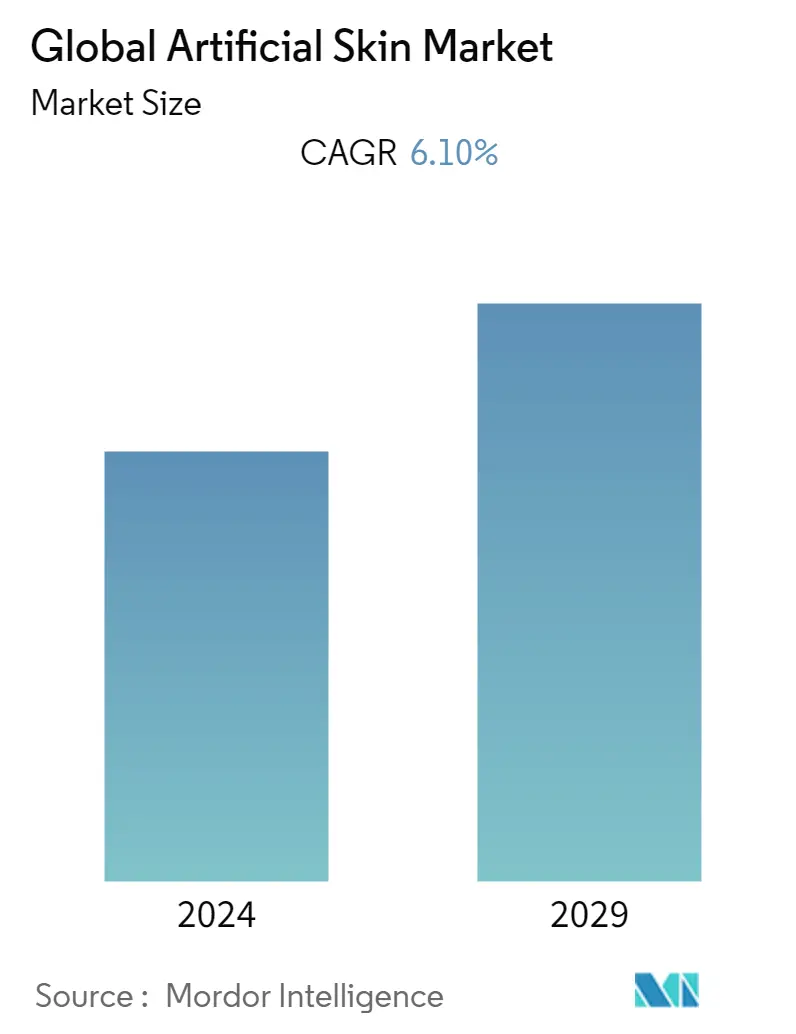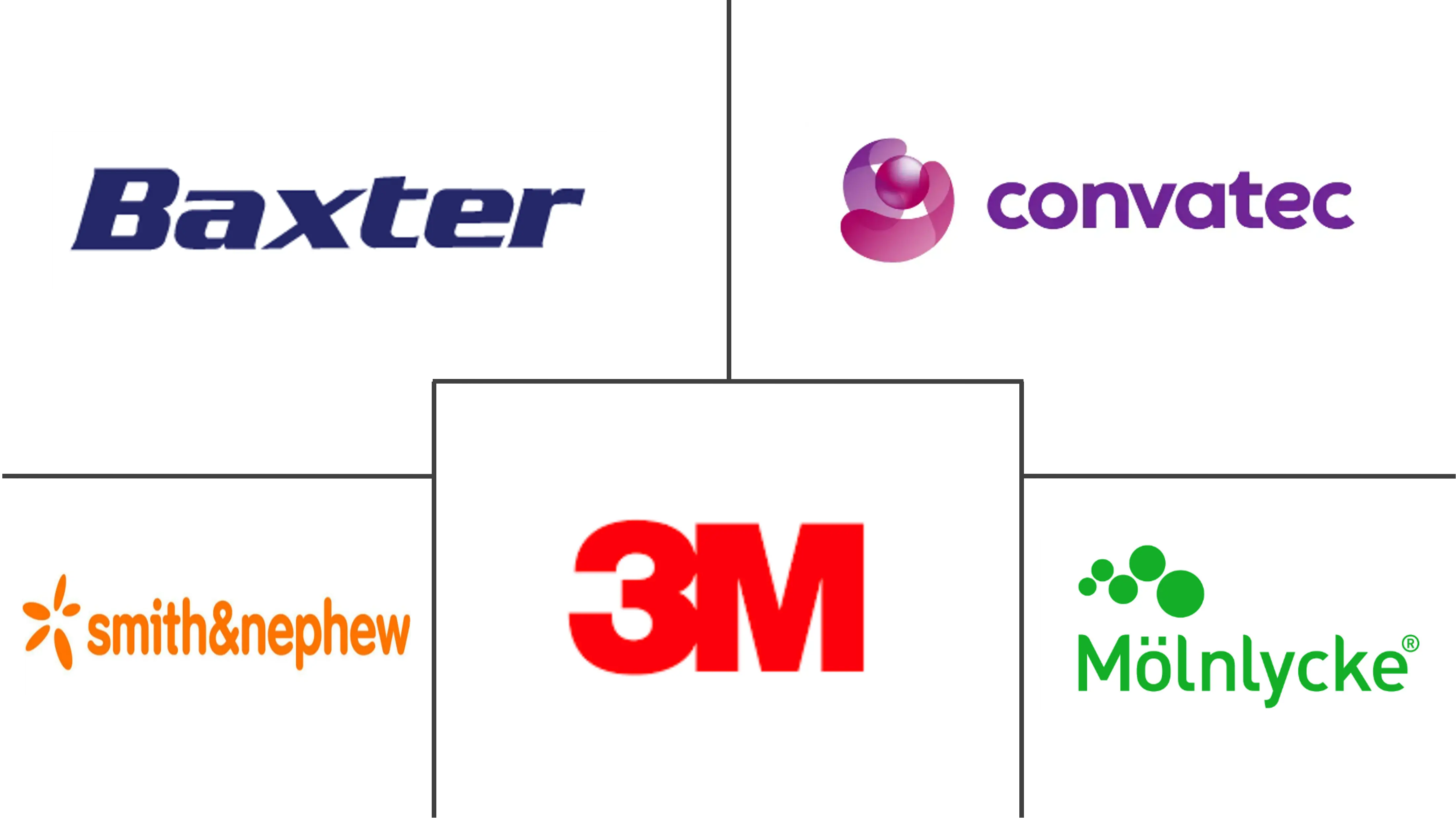Market Size of Global Artificial Skin Industry

| Study Period | 2019 - 2029 |
| Base Year For Estimation | 2023 |
| CAGR | 6.10 % |
| Fastest Growing Market | Asia Pacific |
| Largest Market | North America |
| Market Concentration | Medium |
Major Players
*Disclaimer: Major Players sorted in no particular order |
Artificial Skin Market Analysis
The artificial skin market is expected to register a CAGR of 6.1% over the forecast period.
The increasing number of cases of chronic diseases due to the pandemic's outbreak has accelerated the market's growth during the pandemic. According to the study titled, "Impact of COVID-19 pandemic on chronic diseases care follow-up and current perspectives in low resource settings: a narrative review" published by the National Library of Medicine in June 2021, COVID-19 patients with hypertension, diabetes, and coronary heart disease are more likely to progress to severe conditions. It also reported that patients with COVID-19 are less likely to be cured. The high rate of chronic diseases has triggered a high rate of chronic wounds as well. Chronic wounds arise as a result of a prolonged inflammatory phase during the healing process, which prevents skin regeneration. In addition, COVID-19 patients experience slow wound healing, which has triggered the rate of chronic wounds. According to a journal published by The Ohio State University in February 2021, a diabetes patient who has suffered from COVID-19 is witnessing slow wound healing. Typical treatment of chronic wounds involves the application of autografts, cadaveric allografts, and topical administration of antioxidant, anti-inflammatory, and antibacterial agents. Many artificial skin products are used for the treatment of chronic wounds. For instance, Dermagraft is FDA approved for the treatment of neuropathic and diabetic ulcers and wounds secondary to epidermolysis bullosa. Therefore, such factors have anticipated the market's growth during the pandemic.
The increasing awareness of various skin treatment procedures has led to the rising demand for artificial skin. Artificial skin lacks immunogenic cells like dendritic cells, and hence auto-rejection is not observed. The increase in the number of road accidents, burns, and trauma-related incidents has led to significant growth in the artificial skin market. According to the report published by the American Burn Association in February 2021, around 400,000 people are treated for burns each year in the United States. Thus, the artificial skin market is anticipated to witness a considerable growth rate over the forecast period.
However, the high cost of treatment, lack of reimbursements, and stringent regulatory norms are likely to impede the market's growth over the forecast period.
Artificial Skin Industry Segmentation
As per the scope of the report, artificial skin is a synthetic substitute for human skin that can induce the regeneration of the skin. The skin is the largest organ in the human body and comprises two layers, namely, the epidermis and dermis. Severe burns and wounds make the body vulnerable to infections and impair the healing process. Artificial skin helps to overcome this obstacle and quickens the healing of wounds and burns. Artificial skin does not contain any immunogenic cells, hence not rejected by the body. The artificial skin market is segmented by Product type (Permanent, Temporary, and Composite), by Replacement Area (Dermal, Epidermal, and Composed) by Material (Natural, Synthetic and Both), By Application (Acute Wounds, Chronic Wounds, and Others), By End User ( Hospitals, Burn Care Centers and Others), and (North America, Europe, Asia-Pacific, Middle East, and Africa, and South America). The market report also covers the estimated market sizes and trends for 17 different countries across major regions, globally. The report offers the value (in USD million) for the above segments.
| By Product Type | |
| Permanent | |
| Temporary | |
| Composite |
| By Replacement area | |
| Dermal | |
| Epidermal | |
| Composed |
| By Material | |
| Natural | |
| Synthetic | |
| Both |
| By Application | |
| Acute wounds | |
| Chronic wounds | |
| Others |
| By End User | |
| Hospitals | |
| Burn care Centers | |
| Others |
| Geography | ||||||||
| ||||||||
| ||||||||
| ||||||||
| ||||||||
|
Global Artificial Skin Market Size Summary
The artificial skin market is poised for significant growth, driven by an increasing prevalence of chronic wounds and a rising awareness of skin treatment procedures. The demand for artificial skin is bolstered by its application in treating chronic wounds, which are often a result of prolonged inflammatory healing processes. The COVID-19 pandemic has further accelerated market expansion, as patients with chronic diseases like diabetes and hypertension experience slower wound healing, necessitating advanced treatment options such as artificial skin. The market is also experiencing growth due to the rising incidence of road accidents, burns, and trauma-related injuries, which require effective skin regeneration solutions. Despite the promising growth trajectory, challenges such as high treatment costs, lack of reimbursements, and stringent regulatory norms may impede market progress.
North America is expected to lead the artificial skin market, supported by a high prevalence of chronic wounds linked to chronic diseases and an aging population. The region's growth is further fueled by the increasing obesity rates, which contribute to conditions like vascular insufficiency, delaying wound healing. The competitive landscape of the market is characterized by the presence of major players and the entry of small and medium-sized enterprises, enhancing market dynamics. Key product launches and regulatory approvals, such as the FDA's approval of StrataGraft for thermal burns, are anticipated to drive market growth in the United States. The market's competitive nature is underscored by the activities of prominent companies like Integra Lifesciences Corporation, Smith & Nephew Plc, and Medtronic, among others, who are actively involved in product development and strategic partnerships.
Global Artificial Skin Market Size - Table of Contents
-
1. MARKET DYNAMICS
-
1.1 Market Overview
-
1.2 Market Drivers
-
1.2.1 Advancement in Healthcare Based Technology
-
1.2.2 Elevated Need for Skin Grafts
-
1.2.3 High Incidence of Acute and Chronic wounds
-
1.2.4 Increasing Awareness on Various Skin Treatments
-
-
1.3 Market Restraints
-
1.3.1 High Cost of Treatment and Lack of Reimbursements
-
1.3.2 Stringent Regulatory Norms
-
-
1.4 Porter's Five Force Analysis
-
1.4.1 Threat of New Entrants
-
1.4.2 Bargaining Power of Buyers/Consumers
-
1.4.3 Bargaining Power of Suppliers
-
1.4.4 Threat of Substitute Products
-
1.4.5 Intensity of Competitive Rivalry
-
-
-
2. MARKET SEGMENTATION
-
2.1 By Product Type
-
2.1.1 Permanent
-
2.1.2 Temporary
-
2.1.3 Composite
-
-
2.2 By Replacement area
-
2.2.1 Dermal
-
2.2.2 Epidermal
-
2.2.3 Composed
-
-
2.3 By Material
-
2.3.1 Natural
-
2.3.2 Synthetic
-
2.3.3 Both
-
-
2.4 By Application
-
2.4.1 Acute wounds
-
2.4.2 Chronic wounds
-
2.4.3 Others
-
-
2.5 By End User
-
2.5.1 Hospitals
-
2.5.2 Burn care Centers
-
2.5.3 Others
-
-
2.6 Geography
-
2.6.1 North America
-
2.6.1.1 United States
-
2.6.1.2 Canada
-
2.6.1.3 Mexico
-
-
2.6.2 Europe
-
2.6.2.1 Germany
-
2.6.2.2 United Kingdom
-
2.6.2.3 France
-
2.6.2.4 Italy
-
2.6.2.5 Spain
-
2.6.2.6 Rest of Europe
-
-
2.6.3 Asia Pacific
-
2.6.3.1 China
-
2.6.3.2 Japan
-
2.6.3.3 India
-
2.6.3.4 Australia
-
2.6.3.5 South Korea
-
2.6.3.6 Rest of Asia-Pacific
-
-
2.6.4 Middle East and Africa
-
2.6.4.1 GCC
-
2.6.4.2 South Africa
-
2.6.4.3 Rest of Middle East and Africa
-
-
2.6.5 South America
-
2.6.5.1 Brazil
-
2.6.5.2 Argentina
-
2.6.5.3 Rest of South America
-
-
-
Global Artificial Skin Market Size FAQs
What is the current Global Artificial Skin Market size?
The Global Artificial Skin Market is projected to register a CAGR of 6.10% during the forecast period (2024-2029)
Who are the key players in Global Artificial Skin Market?
Integra Lifesciences Corporation , Smith & Nephew Plc, Medtronic, Molnycke Health Care AB and Baxter International Inc. are the major companies operating in the Global Artificial Skin Market.

